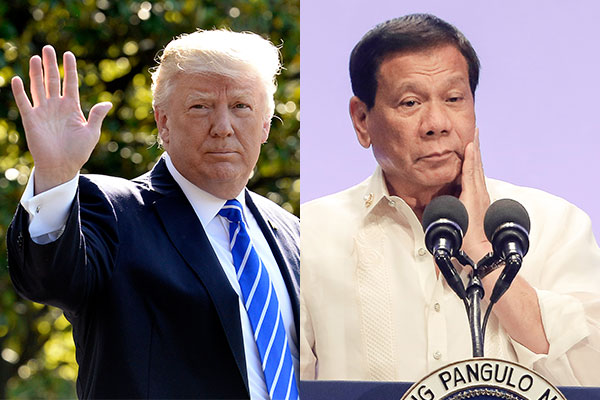Duterte to Trump: What witch-finders can teach us about today’s popular leaders
May 18, 2017 | 5:40am

David Frankfurter, a faculty member of Boston University's Religion Department, argues that there is an interplay between charisma and the discernment of evil in modern leaders that seek a populist appeal. He says his witch-finders shows that an anxious culture may invest itself in a leader who, it feels, can discern and eliminate a pervasive and subversive evil. Philstar.com
(THE CONVERSATION) — It is hardly a new observation that political leaders seeking populist appeal will exacerbate popular fears: about immigrants, terrorists and the other.
President Donald Trump plays to fears of immigrants and Muslims. Benjamin Netanyahu inflames Israeli fears by constantly reminding citizens about the threats around them. And many African leaders bring up fears of satanism and witchcraft. In earlier times, too, American and European leaders invoked threats of communists and Jews.
Such observations explain how leaders use fear to create popular anxiety. But this focus on fear and evil forces, I believe, does something else as well—it could actually contribute to a leader’s charisma. He or she becomes the one person who knows the extent of a threat and also how to address it.
This path to leadership takes place in much smaller-scale situations too, as I have studied in my own work.
In my book “Evil Incarnate,” I analyze this relationship between claims to discern evil and charismatic authority across history, from European and African witch-finders to modern experts in so-called satanic ritual abuse.
How charisma works
In popular parlance, one calls a person charismatic because he or she seems to possess some inner force to which people are drawn.
Social scientists have long perceived this ostensible inner force as the product of social interaction: Charisma, in this interpretation, arises in the interplay between leaders and their audiences. The audiences present their own enthusiasms, needs and fears to the leader. The leader, for his part, mirrors these feelings through his talents in gesture, rhetoric, his conviction in his own abilities and his particular messages about danger and hope.
In sub-Saharan Africa, over the course of the 20th century, charismatic witch-finders swept through villages promising the cleansing of evil. In both Africa and Europe, communities had long been familiar with witches and their modes of attack in general. It has been common in many cultures throughout history to attribute misfortune to witches, who are both a part of society and also malevolent. Misfortunes can thus seem to be the product of human malevolence rather than some abstract divine or natural cause.
Witch-finders, as I see it, have offered four new elements to the “basic” image of witches:
- They proclaimed the immediacy of the threat of witches.
- They revealed the new methods witches were using to subvert the village or afflict children.
- They offered new procedures for interrogating and eliminating witches.
- And most importantly, they proclaimed their own unique capacity to discern the witches and their new techniques to purge them from community.
The witch-finder could show people material evidence of witches’ activity: grotesque dolls or buried gourds, for example. He—rarely she—could coerce others to testify against an accused witch. Often, he would present himself as the target of witches’ active enmity, detailing the threats they had made against him and the attacks he had suffered.
The witch-finder’s authority over—and indispensability to—the growing crisis of threatening evil shaped his charisma. People came to depend on his capacity to see evil and on his techniques of ridding it from the land. An uncleansed village felt vulnerable, awash in malevolent powers, one’s neighbors all suspect; while a village that a witch-finder had investigated seemed safer, calmer, its paths and alleys swept of evil substances.
Witch hunts, satanic cults
Of course, in order for a witch-finder to be successful in activating fears, there were many extenuating circumstances, both historical and social, that had to work in his favor. These could be catastrophes like the plague, or new ways of organizing the world (such as African colonialism), or political tensions—all of which could make his identification of evil people especially useful, even necessary. Also, he had to come off as professional and he had to have the ability to translate local fears in compelling ways.
Indeed, there were many situations in both Europe and Africa when such claims to authority failed to stimulate a sense of crisis or to legitimate witch-finders’ procedures.
For example, in 15th-century Europe, the Franciscan friar Bernardino was able to instigate horrific witch-burnings in Rome but failed to persuade the people of Siena of the dangers witches posed.
But there are times when this pattern has come together and witnessed outright panic and ensuing atrocities. As historians Miri Rubin and Ronald Hsia have described, various such charismatic discerners of evil in medieval and Renaissance Northern Europe (often Christian clergy and friars) promoted false charges against local Jews that they hungered for stolen Eucharists or for the blood of Christian children.
These charismatic leaders organized hunts through Jewish houses to uncover signs of mutilated Eucharist or children’s bones— hunts that swiftly turned into pogroms, as participants in these hunts felt a conspiracy of evil was emerging before them.
The contemporary West has in no way been immune to these patterns on both large and more restricted scales. During the late 1980s and early 1990s, the United States and the United Kingdom found themselves facing a panic over satanic cults, alleged to be sexually abusing children and adults.
In this case, a number of psychiatrists, child protection officers, police and evangelical clergy were styling themselves as experts in discerning the abuses of satanists both in daycare centers and among psychiatric patients. Many people came to believe in the urgency of the satanic threat. Yet no evidence for the existence of such satanic cults ever came to light.
Needs of an anxious culture
In many ways, we can see a similar interplay between charisma and the discernment of evil in those modern leaders that seek a populist appeal.
For example, in his campaign, Trump insisted that he alone could utter the words “radical Islamic terrorism” which assured members of his audience that only Trump was calling out “the terrorist threat.” In Philippines, President Rodrigo Duterte threatened publicly to eat the liver of the terrorists there. These leaders, I believe, are trying to convey that there is a larger threat out there and, even more, they are assuring people that the leader alone understands the nature of that larger threat. Trump’s several attempts to ban Muslim visitors since his election have made his supporters feel understood and safer.
As my work on witch-finders shows, an anxious culture may invest itself in a leader who, it feels, can discern and eliminate a pervasive and subversive evil. Perhaps, in today’s world, the terrorist has become the new “witch”: a monstrous incarnation of evil, posing a unique threat to our communities and undeserving of normal justice.
Do our leaders provide the charismatic leadership for this current era?
______
This article was originally published on The Conversation. Read the original article here: What witch-finders can teach us about today’s world
BrandSpace Articles
<
>
- Latest
Latest
Latest
December 30, 2024 - 1:30pm
December 30, 2024 - 1:30pm
December 28, 2024 - 4:15pm
By Rupert Paul Manhit | December 28, 2024 - 4:15pm
December 21, 2024 - 4:34pm
By Renato Cruz De Castro | December 21, 2024 - 4:34pm
December 14, 2024 - 5:58pm
By Jing Castañeda | December 14, 2024 - 5:58pm
December 14, 2024 - 11:22am
By Karry Sison | December 14, 2024 - 11:22am
December 9, 2024 - 2:53pm
By Rupert Paul Manhit | December 9, 2024 - 2:53pm
Recommended





























